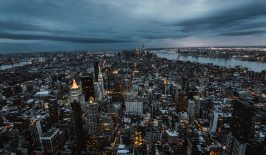A new flying taxi-bubble is about to get tested on the river Seine in Paris: powered by green energy and producing zero emissions, it promises to help relieve traffic congestion and improve air quality in urban centres, and to make urban mobility just that little bit smarter.
Looking like something right out of a sci-fi movie, Seabubbles have come up with a smart mobility solution that is powered entirely by green energy, produces no noise or emissions, and by using waterways, can also help reduce the traffic jams in our ever more congested cities. Seabubbles comprise a fleet of taxi-bubbles, docks, an app – and the system is to be tested in Paris in September this year.
According to the Seabubbles website, some four billion cars are forecast to be on the road globally by 2050. Although the share of electric vehicles is set to rise too, with most of us also living in cities by then, this development has huge potential for noise and air pollution prevention, and for carbon emission reductions.
Their bubble-shaped water cars have enough room for five people, including the driver. They are noiseless, stable, and can travel at speeds of up to 30 km/hour. As soon as a speed of 12km/hour is reached, two electrical engines inside their hull allow the bubbles to lift up and hover two feet above water: this reduces drag and helps keep down their energy consumption.
 © Seabubbles The Seabubble docks are to act as charging stations, powered by a combination of solar, hydraulic and wind power.
© Seabubbles The Seabubble docks are to act as charging stations, powered by a combination of solar, hydraulic and wind power.Taxis powered entirely by renewable energy
The docks (essentially the taxi-bubbles stations) use renewable energy sources – such as the wave power from rivers – to charge up the bubbles as they come in to offload passengers and load new ones. The aim is to make the docks completely energy independent, and for them to combine solar, hydraulic and wind power in order to be able to produce all the energy that they require. In the long term, the plan is also for the docks to feed green energy back into the city grid.
Last but not least, the taxi service is supported by a mobile app through which passengers can search for and book their taxi bubbles, as well as find the nearest docks from which to catch them.
What’s on the horizon for Seabubbles?
While at this stage the bubbles are designed to fly only on rivers, lakes and calm water systems, the team are already at work to produce a model that’s also suitable for use at sea.
Further pilot projects are in the pipeline for England, the US and in Switzerland, and Seabubbles aims to be in 50 cities within five years. In the future they also hope to be able to produce their flying-taxi system entirely within the countries in which they are active – meaning no shipping costs and reduced travel emissions. And autonomous bubbles that drive themselves shouldn’t be far off either.
For more information, and to become a licensed Seabubbles pilot, head to their website. And here’s a short video about the plan:









